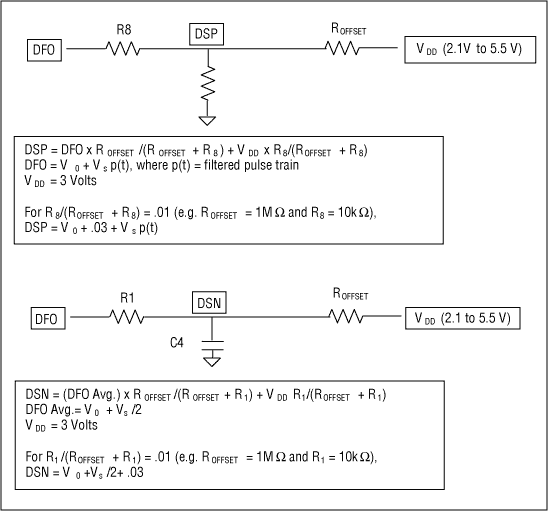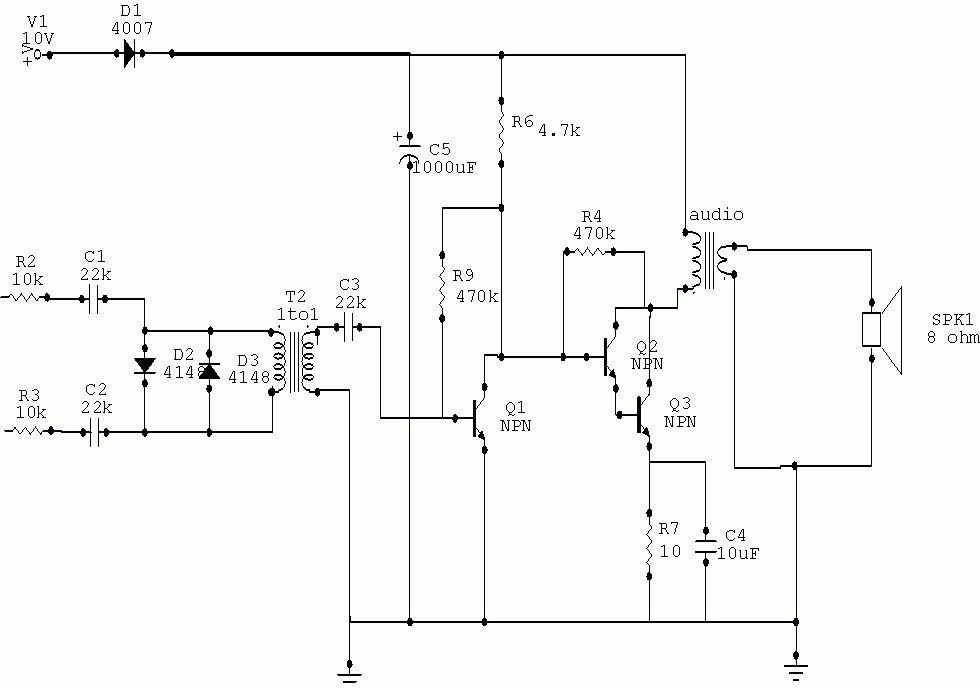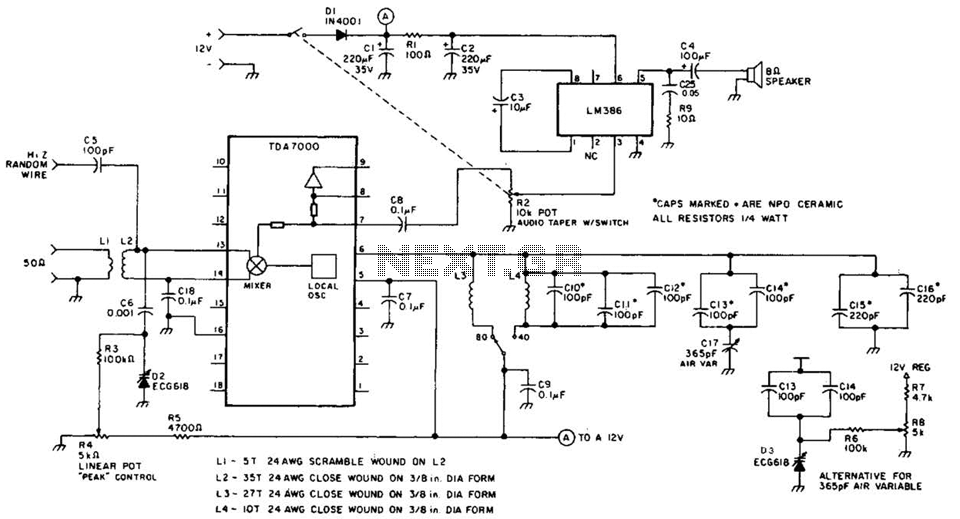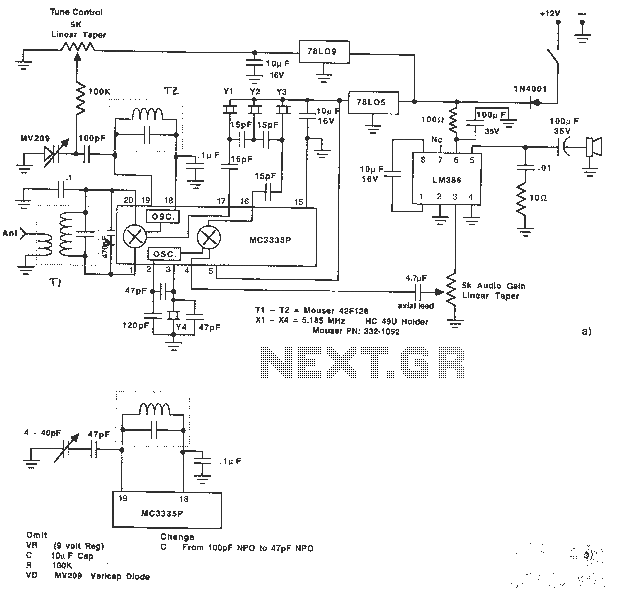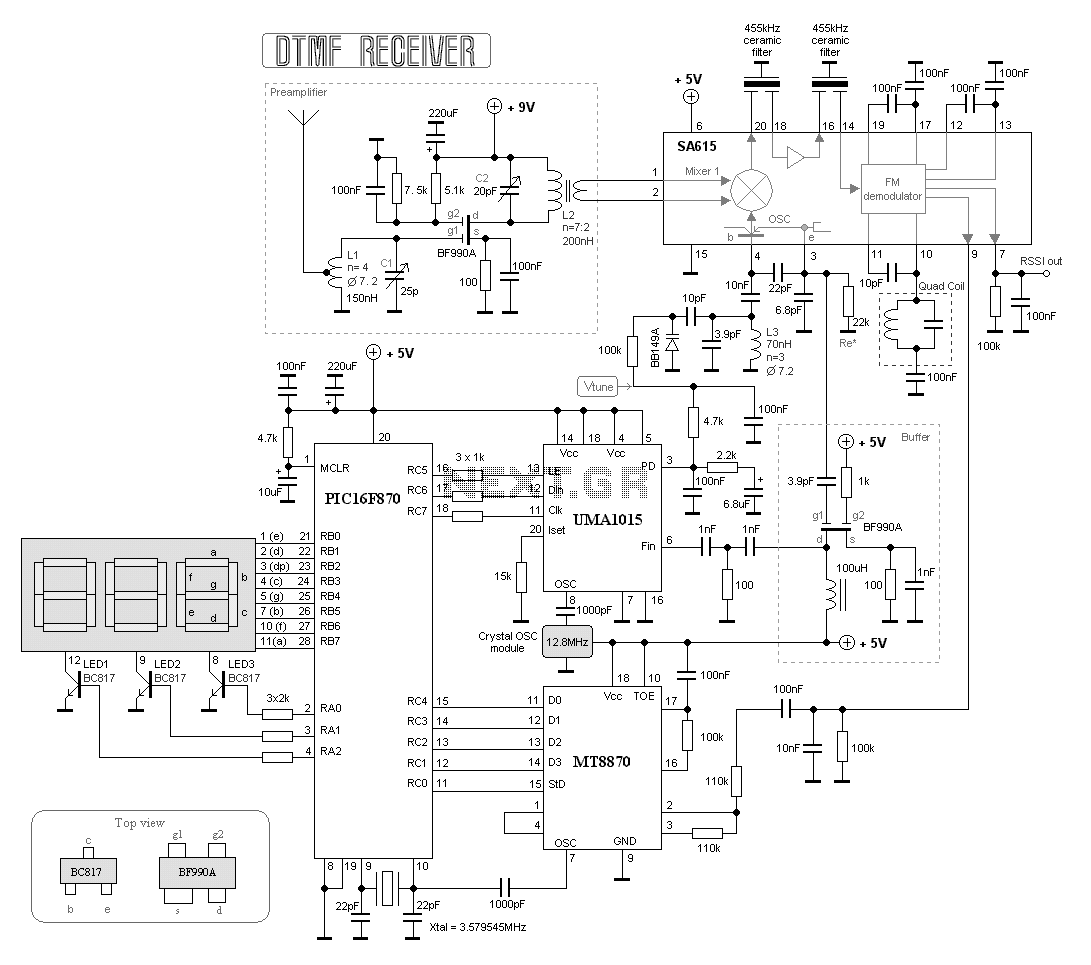
MK414 SW Receiver
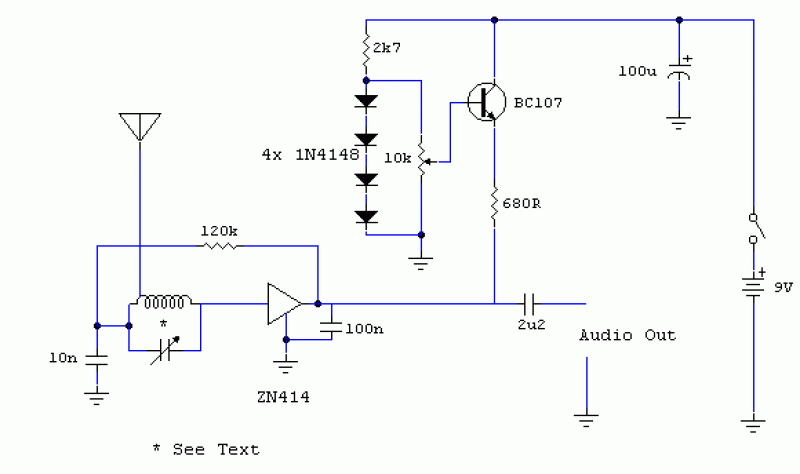
The original data sheet for the MK414 indicates that the maximum working frequency is approximately 4 MHz. SW transmissions are sufficiently strong that this receiver can effectively operate with signals up to about 6 or 7 MHz. A 10k resistor regulates the operating voltage for the integrated circuit (IC), which is crucial for optimal performance. The tuned circuit comprises a variable capacitor and a fixed air-spaced coil. The coil is constructed by winding between 10 and 20 turns of wire around an empty tube with a diameter of approximately 1.5 inches. The spacing of the turns results in an overall length of about 3 inches. The variable capacitor is adjustable from 0 to 300 pF, allowing for experimentation. Additionally, an external antenna is necessary for receiving broadcasts. A 7-meter-long outside wire has proven to be effective. The antenna can be connected at either end of the coil or through a series capacitor with a value ranging from 10 pF to 100 pF.
The MK414 is a versatile integrated circuit designed for use in low-frequency radio receivers. With a maximum working frequency of around 4 MHz, it is capable of handling shortwave signals up to 6 or 7 MHz, making it suitable for various amateur radio applications. The use of a 10k resistor to control the operating voltage is essential, as it ensures that the IC operates within its specified parameters, thereby enhancing performance and reliability.
The tuned circuit, which is a critical component of the receiver, consists of a variable capacitor and a fixed air-spaced coil. The coil, constructed with 10 to 20 turns of wire, is wound around a tube with a diameter of approximately 1.5 inches. This design allows for a compact form factor while maintaining effective inductance. The overall length of the coil is about 3 inches, which contributes to the tuning characteristics of the circuit.
The variable capacitor, adjustable from 0 to 300 pF, provides flexibility in tuning the receiver to different frequencies. This adjustability allows users to experiment with different configurations to optimize performance based on specific reception conditions.
To facilitate effective signal reception, an external antenna is required. A wire antenna measuring approximately 7 meters in length has been identified as effective for this application. The antenna can be connected either at one end of the coil or through a series capacitor, with values ranging from 10 pF to 100 pF, which can further enhance tuning and reception capabilities.
Overall, this configuration of the MK414 receiver circuit, with its tuned circuit and antenna setup, provides a robust platform for receiving shortwave broadcasts, allowing for experimentation and optimization in various radio applications.The original data sheet for the MK414 states a maximum working frequency is around 4 MHz. SW transmissions are so powerful that this receiver will work well with signals up to about 6 or 7 MHz. The 10k resistor controls the operating voltage for the IC which is critical for good performance. The tuned circuit consists of a variable capacitor and f
The MK414 is a versatile integrated circuit designed for use in low-frequency radio receivers. With a maximum working frequency of around 4 MHz, it is capable of handling shortwave signals up to 6 or 7 MHz, making it suitable for various amateur radio applications. The use of a 10k resistor to control the operating voltage is essential, as it ensures that the IC operates within its specified parameters, thereby enhancing performance and reliability.
The tuned circuit, which is a critical component of the receiver, consists of a variable capacitor and a fixed air-spaced coil. The coil, constructed with 10 to 20 turns of wire, is wound around a tube with a diameter of approximately 1.5 inches. This design allows for a compact form factor while maintaining effective inductance. The overall length of the coil is about 3 inches, which contributes to the tuning characteristics of the circuit.
The variable capacitor, adjustable from 0 to 300 pF, provides flexibility in tuning the receiver to different frequencies. This adjustability allows users to experiment with different configurations to optimize performance based on specific reception conditions.
To facilitate effective signal reception, an external antenna is required. A wire antenna measuring approximately 7 meters in length has been identified as effective for this application. The antenna can be connected either at one end of the coil or through a series capacitor, with values ranging from 10 pF to 100 pF, which can further enhance tuning and reception capabilities.
Overall, this configuration of the MK414 receiver circuit, with its tuned circuit and antenna setup, provides a robust platform for receiving shortwave broadcasts, allowing for experimentation and optimization in various radio applications.The original data sheet for the MK414 states a maximum working frequency is around 4 MHz. SW transmissions are so powerful that this receiver will work well with signals up to about 6 or 7 MHz. The 10k resistor controls the operating voltage for the IC which is critical for good performance. The tuned circuit consists of a variable capacitor and f
ixed air spaced coil. For the coil, I wound between 10 and 20 turns of wire on an empty tube of around 1. 5 inches diameter. The turns were spaced so that the overall length was around 3 inches. The variable capacitor tuned 0 - 300 pF but there is plenty of scope for experiment here. One final point, you will need an external antenna to receive broadcasts. I have an outside wire that is about 7 meters long and this was quite effective. The antenna can be connected at either end of the coil or via a series capacitor value between 10pF and 100pF.
🔗 External reference
